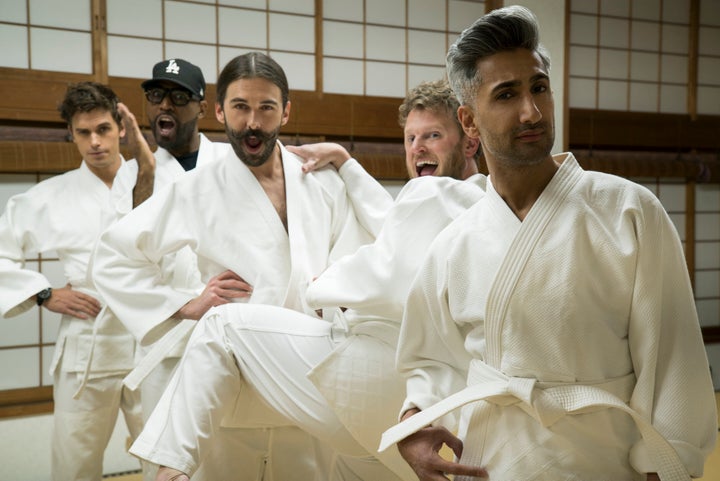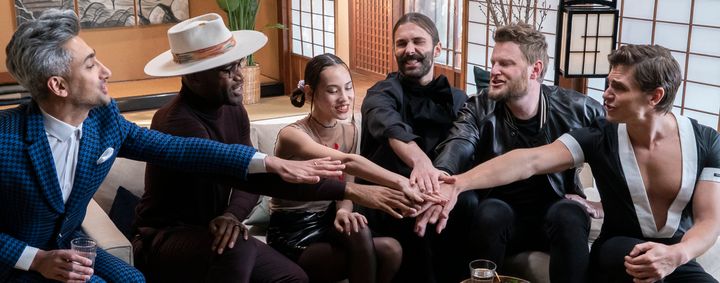
The Netflix Highlight: “Queer Eye: We’re In Japan!” Season 1
What’s up: Netflix’s “Queer Eye: We’re In Japan!” is a special, Japan-set season of the reality makeover show “Queer Eye.” The full cast travels to Japan, where they team up with U.S.-born, Japan-raised model Kiko Mizuhara. Together, they explore Tokyo and make over the lives of “heroes” (the term the show uses to describe the makeover subjects).
This season follows the same basic format of regular “Queer Eye” seasons, but with a slightly expanded scope. Unlike the seasons set in the U.S. South, this season spends much time highlighting the beauty of the backdrop. The cast takes care to learn Japanese customs. As such, the season blends the travel show genre with the makeovers.
This season begins in a much more staged way than normal. The opening features Mizuhara tapping on her phone with one finger. She “sends” a text message to the cast: “Japan needs ‘Queer Eye’!” The cast members all “receive” this message and then nod their heads. Tan France “texts” back “Kiko Mizuhara!” to Mizuhara. Then, through animation, the cast flies to Japan.
The main cast includes Bobby Berk, Karamo Brown, Tan France, Antoni Porowski and Jonathan Van Ness, with Mizuhara also appearing this season.
“Queer Eye: We’re In Japan!” runs four episodes of roughly 50 minutes each.
Sum-up: Given the linguistic and cultural barriers, this season doesn’t feature the same emotional connections between crew and heroes of the stateside seasons. As much as it tries, it simply isn’t the same tear-jerker. That said, the charismatic crew still carry the episodes through sheer force of energy. Their wonder over exploring Tokyo brings a new type of on-screen joy to watch (no such exploratory wonder happens when the crew travels around Georgia). This is ultimately a vacation to experience vicariously.
The show’s makeover formula doesn’t quite translate, though. The first episode focuses on a woman who runs a hospice, rarely changes her clothes and sleeps on the floor under a table. In a confusing aspect of the episode, she states she has also given up on the idea of being a woman, something Mizuhara explains is common for older women to do in Japan. Per the show’s explanation, this means giving up on appearing physically attractive per the cultural standard.
While stateside, the crew seems to have all the answers, but the Fab Five look unsure of what to do with these heavy revelations. In the second episode, the show decides to make over an already-stylish and fairly thriving young gay man. They frame the episode around how hard it will be for the man to express his sexuality in Japan. But at the end of the episode, the hero just seems fine and mostly indifferent to the makeover.
Basically, this season is for the “Queer Eye” completists rather than a first-time viewer.
Heads up: This season comes across as much more forced and unnatural than the stateside equivalents. The cast doesn’t speak Japanese and communicates via an unseen translator, yet many scenes are edited so that people appear to be talking to each other and reacting without a translation, which comes across as fake. The traditional version of the show is at its best when the cast members have heart-to-hearts with the heroes ― when they can authentically cry with them. This season tries to manufacture these moments, and it doesn’t work.
Close-up: In an episode called “Japanese Holiday,” the show repeatedly reminds the viewer that the hero wants to be more like Audrey Hepburn, the star of the movie “Roman Holiday.” The cast repeats her name over and over again. The episode frames the makeover as making the hero more like the actress.
In France’s style makeover, he has the hero meet him in a hotel suite overlooking the city. He says he wants to give the hero a “beautiful experience” by hanging out in the beautiful room with the beautiful model and co-host this season, Mizuhara. The model says how it’s always beautiful to embrace fashion and that the hero shouldn’t be embarrassed to do so. Then France has the hero try on new clothes he describes as Hepburn-esque.
The show tries to frame this as convincing the hero to believe that she can be beautiful. But the extreme clunkyness of framing this ideal around traditional beauty, lavishness and model-esque physical beauty makes the scene incredibly strained. The awkward scene is one of the most shallow of the series (even given that this series often stumbles into shallow moments).

History: In July 2019, Taiga Ishikawa became the first openly gay man to earn a spot in Japan’s National Diet (the national legislature). The politician ran on a platform of marriage equality. “Since the early 2000s, the issue of same-sex marriage has progressed leaps and bounds,” Ishikawa said upon election. “It will happen within the six years of my term, I am sure.”
Comparable Shows: This special season doesn’t stray too far from the typical “Queer Eye” format. The climactic makeover scenes still center around fancy housing upgrades and physical beauty transformations, matching the various “Extreme Makeover” series. But unlike the “Extreme Makeover” series, the show does a strong job of bringing in messages of inner beauty and acceptance as well.
The Characters And Money: The heroes tend to have few possessions in this season. Not having beds is a recurring theme. As the show has done in the past, the “Queer Eye” team gifts the heroes with various monetary upgrades. In the U.S. episodes, the upgrades tend to transform decent living spaces into opulent ones. These episodes feature the crew also giving basic necessities.
Bonus: Berk tweeted a photo of himself kissing the hero from the premiere episode. He called her “the embodiment of love, selflessness, humility and kindness.”
“Queer Eye: We’re In Japan!” Trailer:
A Couple Of Netflix News Stories From This Week
1. In a test, Netflix allowed Android mobile viewers to change the playback speed on streaming content. This means that viewers could watch shows and movies at faster or slower speeds depending on preference. Creators such as Judd Apatow tweeted in anger about this decision. In a blog, Netflix responded by saying subscribers had frequently requested this feature. The feature probably won’t become available on televisions anytime soon.
2. The New York Times has a piece about a recent feud between Netflix and movie theater chains. The fight stems from the failed widespread theatrical release of Martin Scorsese’s upcoming “The Irishman.” As The New York Times reported, Netflix couldn’t work out an agreement with the movie chains due to a disagreement over exclusivity windows. Here’s a paragraph from the report:
The major exhibitors typically insist on a 72-day period of exclusivity for the films that play on their screens. During the monthslong talks with Netflix over “The Irishman,” representatives of two major chains agreed independently to lower that number to around 60, according to two people familiar with the negotiations who were not authorized to discuss them publicly; Netflix signaled that it would not go above 45. And that’s where it ended.
And here are the shows and movies that joined Netflix this week:
Oct. 28
- “A 3 Minute Hug” (Netflix Original)
- “Little Miss Sumo” (Netflix Original)
- “Shine On With Reese” (Season 1)
Oct. 29
- “Arsenio Hall: Smart & Classy” (Netflix Original)
Oct. 30
- “Flavorful Origins: Yunnan Cuisine” (Netflix Original)
Oct. 31
- “Kengan Ashura: Part ll” (Netflix Anime)
- “Nowhere Man” (Netflix Original)
- “Raging Bull”
Nov. 1
- “American Son” (Netflix Television Event)
- “Atypical’ (Season 3, Netflix Original)
- “Drive” (Netflix Film)
- “Fire in Paradise” (Netflix Documentary)
- “Hache” (Netflix Original)
- “Hello Ninja” (Netflix Family)
- “Holiday in the Wild” (Netflix Film)
- “The King” (Netflix Film)
- “The Man Without Gravity” (Netflix Film)
- “Queer Eye: We’re in Japan!” (Netflix Original)
- “True: Grabbleapple Harvest” (Netflix Family)
- “We Are the Wave” (Netflix Original)
- “Apache Warrior”
- “Barbie Dreamhouse Adventures: Go Team Roberts” (Season 1)
- “Billy on the Street”
- “Christmas Break-In”
- “Christmas in the Heartlands”
- “Christmas Survival”
- “Elliot the Littlest Reindeer”
- “Fear and Loathing in Las Vegas”
- “Grease”
- “Holly Star”
- “How to Be a Latin Lover”
- “Love Jones”
- “Mars” (Season 2)
- “Mobile Suit Gundam: Iron-Blooded Orphans” (Seasons 1-2)
- “Paid in Full”
- “Rosemary’s Baby”
- “Rounders”
- “Santa Girl”
- “Sling Blade”
- “Spitfire: The Plane That Saved the World”
- “Step Brothers”
- “The Christmas Candle”
- “The Deep” (Season 3)
- “The Game”
- “The Matrix”
- “The Matrix Reloaded”
- “The Matrix Revolutions”
- “Up North”
- “Wild Child”
- “Zombieland”
